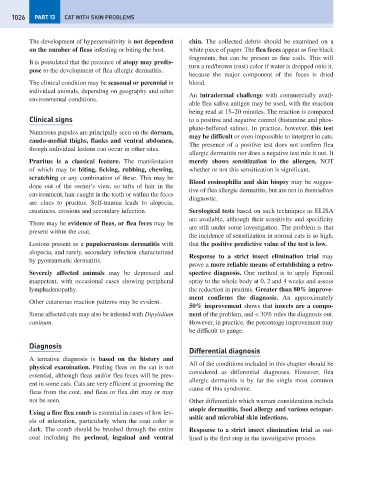Page 1034 - Problem-Based Feline Medicine
P. 1034
1026 PART 13 CAT WITH SKIN PROBLEMS
The development of hypersensitivity is not dependent chin. The collected debris should be examined on a
on the number of fleas infesting or biting the host. white piece of paper. The flea feces appear as fine black
fragments, but can be present as fine coils. This will
It is postulated that the presence of atopy may predis-
turn a red/brown (rust) color if water is dropped onto it,
pose to the development of flea allergic dermatitis.
because the major component of the feces is dried
The clinical condition may be seasonal or perennial in blood.
individual animals, depending on geography and other
An intradermal challenge with commercially avail-
environmental conditions.
able flea saliva antigen may be used, with the reaction
being read at 15–20 minutes. The reaction is compared
Clinical signs to a positive and negative control (histamine and phos-
phate-buffered saline). In practice, however, this test
Numerous papules are principally seen on the dorsum,
may be difficult or even impossible to interpret in cats.
caudo-medial thighs, flanks and ventral abdomen,
The presence of a positive test does not confirm flea
though individual lesions can occur in other sites.
allergic dermatitis nor does a negative test rule it out. It
Pruritus is a classical feature. The manifestation merely shows sensitization to the allergen, NOT
of which may be biting, licking, rubbing, chewing, whether or not this sensitization is significant.
scratching or any combination of these. This may be
Blood eosinophilia and skin biopsy may be sugges-
done out of the owner’s view, so tufts of hair in the
tive of flea allergic dermatitis, but are not in themselves
environment, hair caught in the teeth or within the feces
diagnostic.
are clues to pruritus. Self-trauma leads to alopecia,
crustiness, erosions and secondary infection. Serological tests based on such techniques as ELISA
are available, although their sensitivity and specificity
There may be evidence of fleas, or flea feces may be
are still under some investigation. The problem is that
present within the coat.
the incidence of sensitization in normal cats is so high,
Lesions present as a papulocrustous dermatitis with that the positive predictive value of the test is low.
alopecia, and rarely, secondary infection characterized
Response to a strict insect elimination trial may
by pyotraumatic dermatitis.
prove a more reliable means of establishing a retro-
Severely affected animals may be depressed and spective diagnosis. One method is to apply Fipronil
inappetent, with occasional cases showing peripheral spray to the whole body at 0, 2 and 4 weeks and assess
lymphadenopathy. the reduction in pruritus. Greater than 80% improve-
ment confirms the diagnosis. An approximately
Other cutaneous reaction patterns may be evident.
50% improvement shows that insects are a compo-
Some affected cats may also be infested with Dipylidium nent of the problem, and < 30% rules the diagnosis out.
caninum. However, in practice, the percentage improvement may
be difficult to gauge.
Diagnosis
Differential diagnosis
A tentative diagnosis is based on the history and
All of the conditions included in this chapter should be
physical examination. Finding fleas on the cat is not
considered as differential diagnoses. However, flea
essential, although fleas and/or flea feces will be pres-
allergic dermatitis is by far the single most common
ent in some cats. Cats are very efficient at grooming the
cause of this syndrome.
fleas from the coat, and fleas or flea dirt may or may
not be seen. Other differentials which warrant consideration include
atopic dermatitis, food allergy and various ectopar-
Using a fine flea comb is essential in cases of low lev-
asitic and microbial skin infections.
els of infestation, particularly when the coat color is
dark. The comb should be brushed through the entire Response to a strict insect elimination trial as out-
coat including the perineal, inguinal and ventral lined is the first step in the investigative process.

